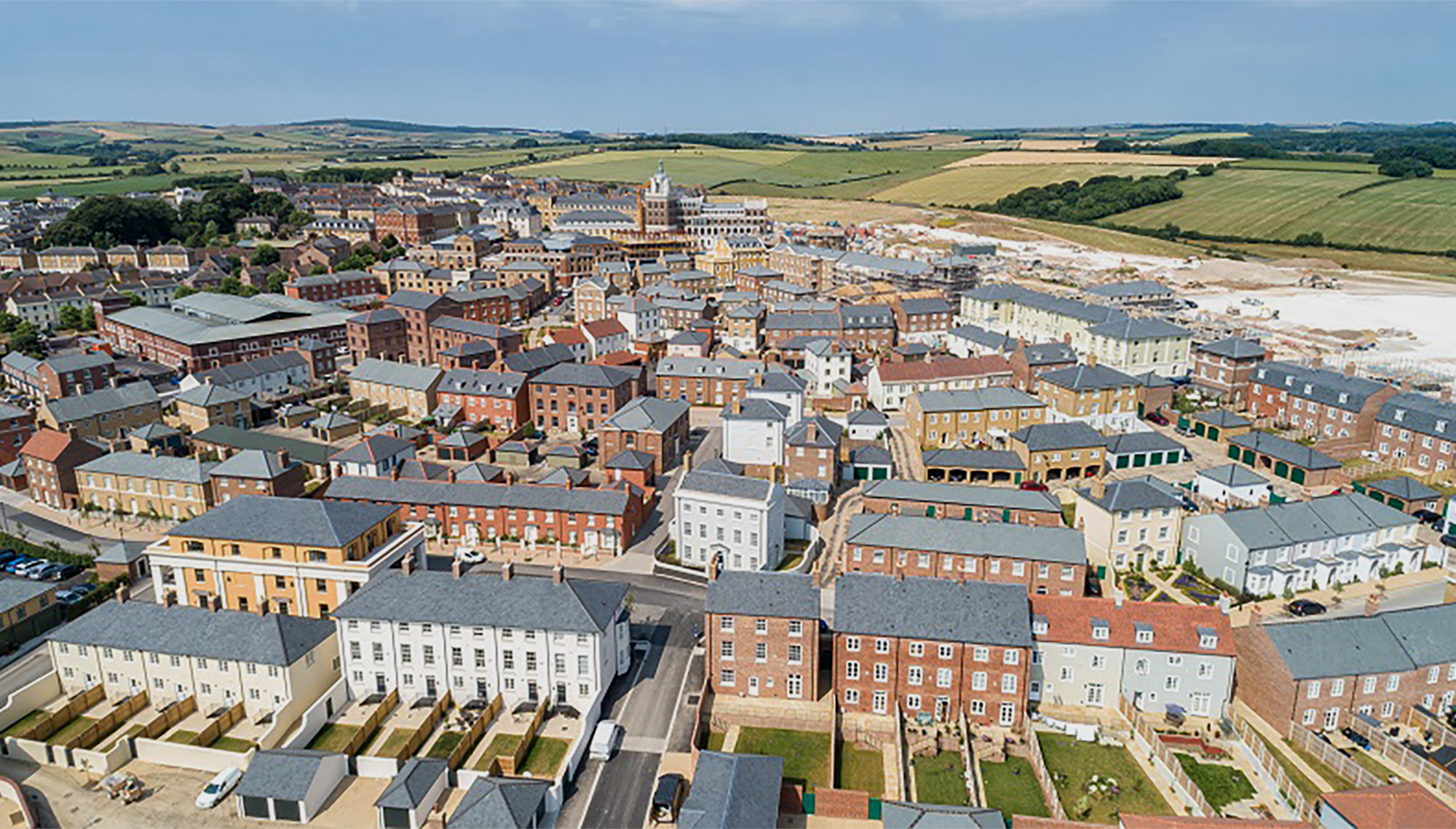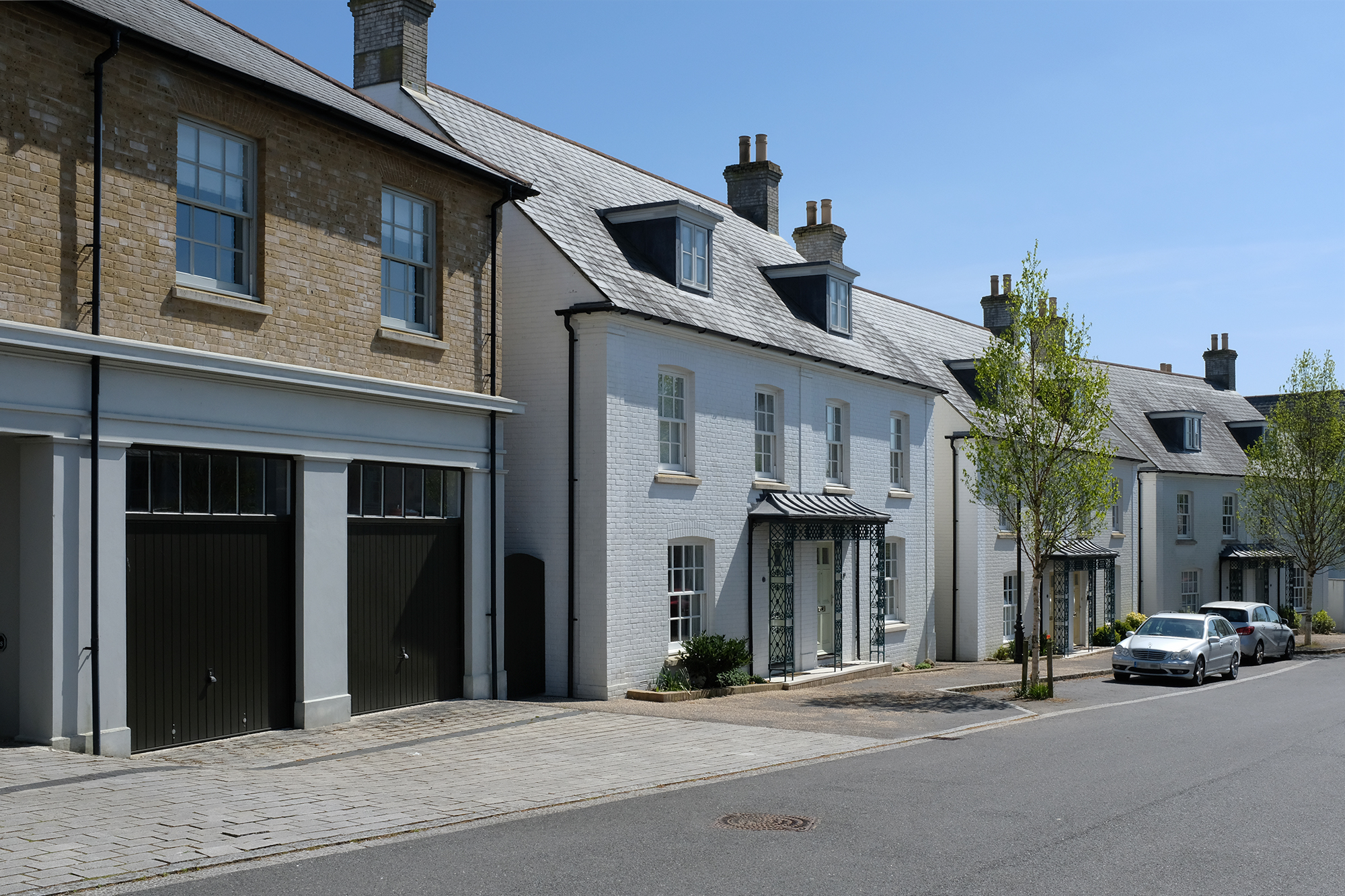Poundbury
13.5.21

On a recent trip to the south coast we stop in at Poundbury, the experimental new town on the edge of Dorchester in the county of Dorset.
Due for completion in 2025, this traditionalist urban ‘model’ village created by architect Léon Krier is the passion project of Charles, Prince of Wales, on whose Duchy of Cornwall land it is built.
It has been criticised as artificially nostalgic, ‘grimly cute’2 ‘a feudal Disneyland’3; while also acknowledged for reviving the low-rise streetscape built to a more human scale, of recognising ‘patterns and examples laid down by tradition’4 and being a place that ‘embodies... innovations that can only be called radical’5.
I agree with both the criticism and the praise about its Neo/Mock design, and am happy to hold opposing opinions about it while I watch it evolve over time. But there is something else that catches my eye today.
Due for completion in 2025, this traditionalist urban ‘model’ village created by architect Léon Krier is the passion project of Charles, Prince of Wales, on whose Duchy of Cornwall land it is built.
It has been criticised as artificially nostalgic, ‘grimly cute’2 ‘a feudal Disneyland’3; while also acknowledged for reviving the low-rise streetscape built to a more human scale, of recognising ‘patterns and examples laid down by tradition’4 and being a place that ‘embodies... innovations that can only be called radical’5.
I agree with both the criticism and the praise about its Neo/Mock design, and am happy to hold opposing opinions about it while I watch it evolve over time. But there is something else that catches my eye today.





As we drive into town, the sky is clear blue, there are very few people around (the kids are at school?) and a few businesses are opening up again post lockdown_3. These factors lend the place an eerie Truman Show6 quality.
But I am disorientated by something else and for a while I can’t tell what it was. Then it hits me: there are no road signs, lines or markings; no meters or traffic lights, and definitely no cctv. Just the occasional heritage bollard and street light, with the latter only ever attached to buildings and not freestanding.
Having driven in from London I wonder how much this stripping away of so much street furniture and road markings contributes to Poundbury’s apparent tranquility. Could it be measured in some way?
Indeed, one of my MA projects, Obstructions, had been about this very subject: the proliferation of prohibitive objects and people in our built environment.
For me, driving around London is stressful. So why drive at all then? I hear you ask. Because sometimes it is necessary, or just better. I also walk, cycle and take public transport, a lot. And I support a reduction in car ownership; but as with Poundbury, I hold opposing opinions at the same time about cars.
Anyway, I am so used to the stressfulness of London driving that I hardly notice it. It is simply baked in to my travel plans. This stressfulness isn’t caused by any one thing, but it is cumulative. Bus lanes, hatched boxes, gyratory systems, one way systems, mini-roundabouts (which most drivers seem to ignore), other drivers texting, road closures, road works, temporary traffic lights, angry van drivers, skittish scooter delivery drivers, bullish bus drivers, inattentive Uber drivers, electric scooter riders, speed bumps, potholes, disappearing lanes, traffic cameras, sirens, double parkers. And that’s before you arrive at your destination and have to dealing with the lack of parking.
So all this very much comes to mind as I enter Poundbury. Imagine starting again with an area: creating people-centric spaces and stripping away all of its traffic systems, double yellow lines and cctv. What unintended consequences lay in wait? Would many of these prohibitive actors creep back in in time?
Poundbury was intended to reduce car dependency and encourage walking, cycling and public transport; but a survey has already shown that its car use is higher than that of the surrounding Dorset area.
Time will tell with Poundbury. But crucially for me it represents a space to experiment with the systems and infrastructure of a built community, even if it is only the passion project of England’s largest remaining feudal landowner.7
But I am disorientated by something else and for a while I can’t tell what it was. Then it hits me: there are no road signs, lines or markings; no meters or traffic lights, and definitely no cctv. Just the occasional heritage bollard and street light, with the latter only ever attached to buildings and not freestanding.
Having driven in from London I wonder how much this stripping away of so much street furniture and road markings contributes to Poundbury’s apparent tranquility. Could it be measured in some way?
Indeed, one of my MA projects, Obstructions, had been about this very subject: the proliferation of prohibitive objects and people in our built environment.
For me, driving around London is stressful. So why drive at all then? I hear you ask. Because sometimes it is necessary, or just better. I also walk, cycle and take public transport, a lot. And I support a reduction in car ownership; but as with Poundbury, I hold opposing opinions at the same time about cars.
Anyway, I am so used to the stressfulness of London driving that I hardly notice it. It is simply baked in to my travel plans. This stressfulness isn’t caused by any one thing, but it is cumulative. Bus lanes, hatched boxes, gyratory systems, one way systems, mini-roundabouts (which most drivers seem to ignore), other drivers texting, road closures, road works, temporary traffic lights, angry van drivers, skittish scooter delivery drivers, bullish bus drivers, inattentive Uber drivers, electric scooter riders, speed bumps, potholes, disappearing lanes, traffic cameras, sirens, double parkers. And that’s before you arrive at your destination and have to dealing with the lack of parking.
So all this very much comes to mind as I enter Poundbury. Imagine starting again with an area: creating people-centric spaces and stripping away all of its traffic systems, double yellow lines and cctv. What unintended consequences lay in wait? Would many of these prohibitive actors creep back in in time?
Poundbury was intended to reduce car dependency and encourage walking, cycling and public transport; but a survey has already shown that its car use is higher than that of the surrounding Dorset area.
Time will tell with Poundbury. But crucially for me it represents a space to experiment with the systems and infrastructure of a built community, even if it is only the passion project of England’s largest remaining feudal landowner.7
1 Picture credits: Artist’s impression, Léon Krier; aerial view, pbctoday; the rest by D Hartley.
General information source: Wikipedia.
2 ‘To visit Poundbury is to be delivered to the furniture floor of a provincial department store in 1954, translated into architecture. It is fake, heartless, authoritarian and grimly cute.’ Bayley, S. (2008). I'll Show you a Real Carbuncle, Charles. The Guardian. 3 ‘Poundbury, the Prince of Wales’s traditionalist village in Dorset, has long been mocked as a feudal Disneyland. But a growing and diverse community suggests it's getting a lot of things right.’ Wainwright, O. (2016) A Royal Revolution: is Prince Charles's Model Village Having the Last Laugh? The Guardian.
4 ‘The proportions are human proportions; the details are restful to the eye. This is not great or original architecture, nor does it try to be; it is a modest attempt to get things right by following patterns and examples laid down by tradition. This is not nostalgia, but knowledge passed on from age to age.’ Scruton, R. (2009) Why Beauty Matters. BBC.
5 ‘Poundbury embodies social, economic, and planning innovations that can only be called radical.’ Rybczynski, W. (2013). Behind the Façade of Prince Charles's Poundbury. Architect magazine.
6 The Truman Show (1998) is a satirical film starring Jim Carrey, where the main character becomes aware that he is secretly the star of a hit reality TV show.
7 The total acreage for the Duchy is estimated to be 135,526 acres. The ‘Duchy in the twenty-first century is nearly twice as large as it was in the Victorian period: the 1873 Return of Owners of Land recorded it as being just 74,113 acres. And these are just the landward acres: in addition, the Duchy owns around 100,000 acres of foreshore and 14,000 acres of estuarial river beds in Cornwall and Devon.’ whoownsengland.org
General information source: Wikipedia.
2 ‘To visit Poundbury is to be delivered to the furniture floor of a provincial department store in 1954, translated into architecture. It is fake, heartless, authoritarian and grimly cute.’ Bayley, S. (2008). I'll Show you a Real Carbuncle, Charles. The Guardian. 3 ‘Poundbury, the Prince of Wales’s traditionalist village in Dorset, has long been mocked as a feudal Disneyland. But a growing and diverse community suggests it's getting a lot of things right.’ Wainwright, O. (2016) A Royal Revolution: is Prince Charles's Model Village Having the Last Laugh? The Guardian.
4 ‘The proportions are human proportions; the details are restful to the eye. This is not great or original architecture, nor does it try to be; it is a modest attempt to get things right by following patterns and examples laid down by tradition. This is not nostalgia, but knowledge passed on from age to age.’ Scruton, R. (2009) Why Beauty Matters. BBC.
5 ‘Poundbury embodies social, economic, and planning innovations that can only be called radical.’ Rybczynski, W. (2013). Behind the Façade of Prince Charles's Poundbury. Architect magazine.
6 The Truman Show (1998) is a satirical film starring Jim Carrey, where the main character becomes aware that he is secretly the star of a hit reality TV show.
7 The total acreage for the Duchy is estimated to be 135,526 acres. The ‘Duchy in the twenty-first century is nearly twice as large as it was in the Victorian period: the 1873 Return of Owners of Land recorded it as being just 74,113 acres. And these are just the landward acres: in addition, the Duchy owns around 100,000 acres of foreshore and 14,000 acres of estuarial river beds in Cornwall and Devon.’ whoownsengland.org